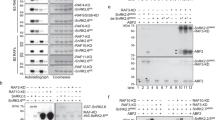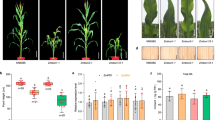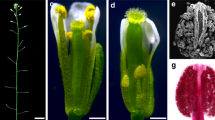Abstract
When brassinosteroid levels are low, the GSK3-like kinase BIN2 phosphorylates and inactivates the BZR1 transcription factor to inhibit growth in plants. Brassinosteroid promotes growth by inducing dephosphorylation of BZR1, but the phosphatase that dephosphorylates BZR1 has remained unknown. Here, using tandem affinity purification, we identified protein phosphatase 2A (PP2A) as a BZR1-interacting protein. Genetic analyses demonstrated a positive role for PP2A in brassinosteroid signalling and BZR1 dephosphorylation. Members of the B’ regulatory subunits of PP2A directly interact with BZR1’s putative PEST domain containing the site of the bzr1-1D mutation. Interaction with and dephosphorylation by PP2A are enhanced by the bzr1-1D mutation, reduced by two intragenic bzr1-1D suppressor mutations, and abolished by deletion of the PEST domain. This study reveals a crucial function for PP2A in dephosphorylating and activating BZR1 and completes the set of core components of the brassinosteroid-signalling cascade from cell surface receptor kinase to gene regulation in the nucleus.
This is a preview of subscription content, access via your institution
Access options
Subscribe to this journal
Receive 12 print issues and online access
$209.00 per year
only $17.42 per issue
Buy this article
- Purchase on Springer Link
- Instant access to full article PDF
Prices may be subject to local taxes which are calculated during checkout





Similar content being viewed by others
References
Kim, T. W. & Wang, Z. Y. Brassinosteroid signal transduction from receptor kinases to transcription factors. Annu. Rev. Plant Biol. 61, 681–704 (2010).
Vert, G., Nemhauser, J. L., Geldner, N., Hong, F. & Chory, J. Molecular mechanisms of steroid hormone signaling in plants. Annu. Rev. Cell Dev. Biol. 21, 177–201 (2005).
Clouse, S. D. Brassinosteroids. Plant counterparts to animal steroid hormones? Vitam. Horm. 65, 195–223 (2002).
Tang, W., Deng, Z. & Wang, Z. Y. Proteomics shed light on the brassinosteroid signaling mechanisms. Curr. Opin. Plant Biol. 23, 27–33 (2010).
Kim, T-W. et al. Brassinosteroid signal transduction from cell-surface receptor kinases to nuclear transcription factors. Nat. Cell Biol. 11, 1254–1260 (2009).
Gendron, J. M. & Wang, Z. Y. Multiple mechanisms modulate brassinosteroid signaling. Curr. Opin. Plant Biol. 10, 436–441 (2007).
Sun, Y. et al. Integration of brassinosteroid signal transduction with the transcription network for plant growth regulation in Arabidopsis. Dev. Cell 19, 765–777 (2010).
Wang, Z. Y. et al. Nuclear-localized BZR1 mediates brassinosteroid-induced growth and feedback suppression of brassinosteroid biosynthesis. Dev. Cell 2, 505–513 (2002).
He, J. X., Gendron, J. M., Yang, Y., Li, J. & Wang, Z. Y. The GSK3-like kinase BIN2 phosphorylates and destabilizes BZR1, a positive regulator of the brassinosteroid signaling pathway in Arabidopsis. Proc. Natl Acad. Sci. USA 99, 10185–10190 (2002).
Yin, Y. et al. BES1 accumulates in the nucleus in response to brassinosteroids to regulate gene expression and promote stem elongation. Cell 109, 181–191 (2002).
MacDonald, B. T., Tamai, K. & He, X. Wnt/β-catenin signaling: components, mechanisms, and diseases. Dev. Cell 17, 9–26 (2009).
Gampala, S. S. et al. An essential role for 14-3-3 proteins in brassinosteroid signal transduction in Arabidopsis. Dev. Cell 13, 177–189 (2007).
Vert, G. & Chory, J. Downstream nuclear events in brassinosteroid signalling. Nature 441, 96–100 (2006).
Bai, M. Y. et al. Functions of OsBZR1 and 14-3-3 proteins in brassinosteroid signaling in rice. Proc. Natl Acad. Sci. USA 104, 13839–13844 (2007).
Kinoshita, T. et al. Binding of brassinosteroids to the extracellular domain of plant receptor kinase BRI1. Nature 433, 167–171 (2005).
Wang, X. & Chory, J. Brassinosteroids regulate dissociation of BKI1, a negative regulator of BRI1 signaling, from the plasma membrane. Science 313, 1118–1122 (2006).
Wang, X. et al. Sequential transphosphorylation of the BRI1/BAK1 receptor kinase complex impacts early events in brassinosteroid signaling. Dev. Cell 15, 220–235 (2008).
Wang, Z. Y., Seto, H., Fujioka, S., Yoshida, S. & Chory, J. BRI1 is a critical component of a plasma-membrane receptor for plant steroids. Nature 410, 380–383 (2001).
Wang, X. et al. Autoregulation and homodimerization are involved in the activation of the plant steroid receptor BRI1. Dev. Cell 8, 855–865 (2005).
Tang, W. et al. BSKs mediate signal transduction from the receptor kinase BRI1 in Arabidopsis. Science 321, 557–560 (2008).
Thummel, C. S. & Chory, J. Steroid signaling in plants and insects—common themes, different pathways. Genes Dev. 16, 3113–3129 (2002).
Zhang, W. et al. PR55α, a regulatory subunit of PP2A, specifically regulates PP2A-mediated β-catenin dephosphorylation. J. Biol. Chem. 284, 22649–22656 (2009).
Su, Y. et al. APC is essential for targeting phosphorylated β-catenin to the SCFβ-TrCP ubiquitin ligase. Mol. Cell 32, 652–661 (2008).
Janssens, V., Longin, S. & Goris, J. PP2A holoenzyme assembly: in cauda venenum (the sting is in the tail). Trends Biochem. Sci. 33, 113–121 (2008).
Mumby, M. The 3D structure of protein phosphatase 2A: new insights into a ubiquitous regulator of cell signaling. ACS Chem. Biol. 2, 99–103 (2007).
Farkas, I., Dombradi, V., Miskei, M., Szabados, L. & Koncz, C. Arabidopsis PPP family of serine/threonine phosphatases. Trends Plant Sci. 12, 169–176 (2007).
Alonso, J. M. et al. Genome-wide insertional mutagenesis of Arabidopsis thaliana. Science 301, 653–657 (2003).
Rashotte, A. M., DeLong, A. & Muday, G. K. Genetic and chemical reductions in protein phosphatase activity alter auxin transport, gravity response, and lateral root growth. Plant Cell 13, 1683–1697 (2001).
Michniewicz, M. et al. Antagonistic regulation of PIN phosphorylation by PP2A and PINOID directs auxin flux. Cell 130, 1044–1056 (2007).
Blakeslee, J. J. et al. Specificity of RCN1-mediated protein phosphatase 2A regulation in meristem organization and stress response in roots. Plant Physiol. 146, 539–553 (2008).
Muday, G. K. et al. RCN1-regulated phosphatase activity and EIN2 modulate hypocotyl gravitropism by a mechanism that does not require ethylene signaling. Plant Physiol. 141, 1617–1629 (2006).
Ryu, H., Kim, K., Cho, H. & Hwang, I. Predominant actions of cytosolic BSU1 and nuclear BIN2 regulate subcellular localization of BES1 in brassinosteroid signaling. Mol. Cell 29, 291–296 (2010).
Mora-Garcia, S. et al. Nuclear protein phosphatases with Kelch-repeat domains modulate the response to brassinosteroids in Arabidopsis. Genes Dev. 18, 448–460 (2004).
De Rybel, B. et al. Chemical inhibition of a subset of Arabidopsis thaliana GSK3-like kinases activates brassinosteroid signaling. Chem. Biol. 16, 594–604 (2009).
Terol, J., Bargues, M., Carrasco, P., Perez-Alonso, M. & Paricio, N. Molecular characterization and evolution of the protein phosphatase 2A B′ regulatory subunit family in plants. Plant Physiol. 129, 808–822 (2002).
Ryu, H. et al. Nucleocytoplasmic shuttling of BZR1 mediated by phosphorylation is essential in Arabidopsis brassinosteroid signaling. Plant Cell 19, 2749–2762 (2007).
Tseng, T. S. & Briggs, W. R. The Arabidopsis rcn1-1 mutation impairs dephosphorylation of Phot2, resulting in enhanced blue light responses. Plant Cell 22, 392–402 (2010).
Luo, W. et al. Protein phosphatase 1 regulates assembly and function of the β-catenin degradation complex. EMBO J. 26, 1511–1521 (2007).
Singh, A. et al. Protein phosphatase 2A reactivates FOXO3a through a dynamic interplay with 14-3-3 and AKT. Mol. Biol. Cell 21, 1140–1152 (2010).
Tang, W. et al. Proteomic studies of brassinosteroid signal transduction using prefractionation and two-dimensional DIGE. Mol. Cell Proteomics 7, 728–738 (2008).
Acknowledgements
This work was financially supported by the Division of Chemical Sciences, Geosciences, and Biosciences, Office of Basic Energy Sciences of the US Department of Energy through Grant DE-FG02-08ER15973, and by NIH (R01GM066258), National Science Foundation of China (30870213, 90917008), NSF (IOS-0724688 and IOS-0846282), and the Herman Frasch Foundation. R.W and M.Y. were supported by the China Scholarship Council. The UCSF Mass Spectrometry Facility (A.L.B., Director) is supported by the Biomedical Research Technology Program of the National Centre for Research Resources, NIH NCRR RR01614, RR012961 and RR019934.
Author information
Authors and Affiliations
Contributions
Z-Y.W. and Y.S. conceived the project and designed the experiments. C.W., M.Y. and Y.S. carried out BZR1 complex purification. Z.D. carried out in-gel digestion, and J.A.O-P. and A.L.B. did the mass spectrometry analysis (Supplementary Fig. S2). W.T. contributed data in Figs 1b,d, 2a–g, 3d, 4d,e,h and Supplementary Figs S4 and S5. M.Y. contributed data in Figs 1c, 2e, 3a–c,e, 4b,c,g, 5b,c and Supplementary Fig. S8. R.W. made contributions to Figs 1a,b, 2a–g, 3d, 4d,e,h and Supplementary Figs S4 and S5. Y.Y. contributed to Fig. 1a, Supplementary Fig. S3, Fig. 4b and Supplementary Fig. S7. T-W.K. contributed Fig. 5a. H-W.Z. and A.D.L. provided the YFP fusions to RCN1 and PP2AA3, the rcn1 pp2aa3 mutant and the anti-PP2AA antibodies. S.S.G. and J.M.G. identified the bzs247 and bzs248 mutants (Fig. 4f). E.M.J. and C.L. provided a p p2a b′αβ mutant and qRT-PCR data (Supplementary Fig. S6). Z-Y.W. and Y.S. wrote the paper together with W.T., M.Y. and R.W.
Corresponding authors
Ethics declarations
Competing interests
The authors declare no competing financial interests.
Supplementary information
Supplementary Information
Supplementary Information (PDF 813 kb)
Rights and permissions
About this article
Cite this article
Tang, W., Yuan, M., Wang, R. et al. PP2A activates brassinosteroid-responsive gene expression and plant growth by dephosphorylating BZR1. Nat Cell Biol 13, 124–131 (2011). https://doi.org/10.1038/ncb2151
Received:
Accepted:
Published:
Issue Date:
DOI: https://doi.org/10.1038/ncb2151
This article is cited by
-
Genome-wide identification and expression analysis of BZR gene family and associated responses to abiotic stresses in cucumber (Cucumis sativus L.)
BMC Plant Biology (2023)
-
Genome-Wide Identification and Expression Analysis of BES1 Family in Catharanthus roseus
Journal of Plant Growth Regulation (2023)
-
Crosstalk between brassinosteroid signaling and variable nutrient environments
Science China Life Sciences (2023)
-
Transcriptomics analysis reveals the signal transduction mechanism of brassinolides in tea leaves and its regulation on the growth and development of Camellia sinensis
BMC Genomics (2022)
-
Evolutionary analysis and functional characterization of BZR1 gene family in celery revealed their conserved roles in brassinosteroid signaling
BMC Genomics (2022)



